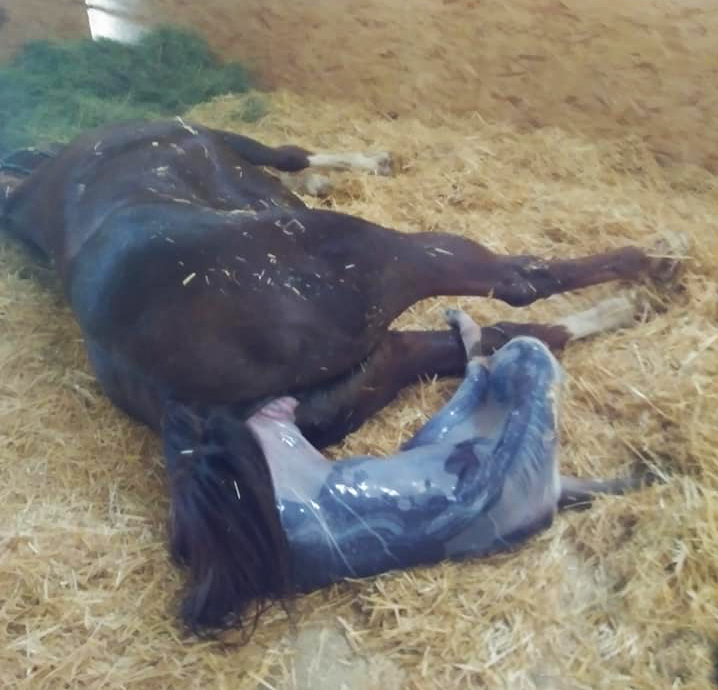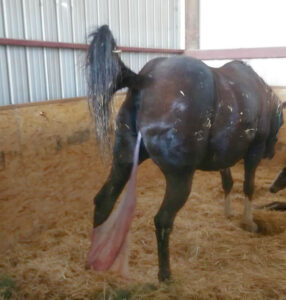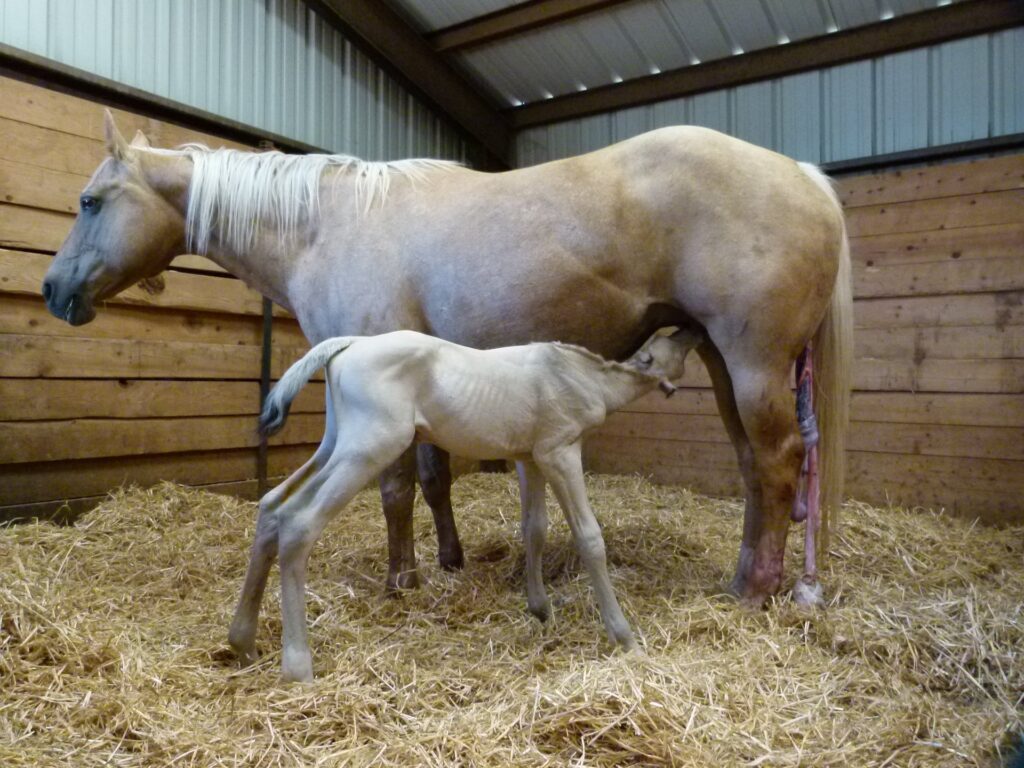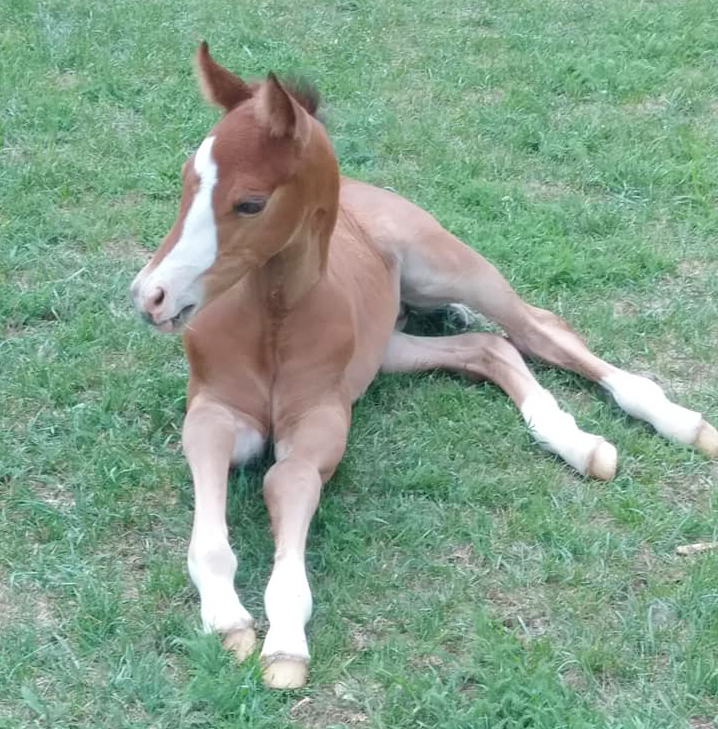
While you’re awaiting the birth of your first foal, it helps to know what to expect.
You have a nice mare, you’ve succeeded in getting her bred, and you are now excitedly awaiting the arrival of her foal. However, as thrilled as you are, you are no doubt a bit nervous too, as you know that giving birth can be dangerous for both the mare and her baby. If you are an inexperienced mare owner, the prospect of the impending birth might make you very anxious indeed, as you’re not sure you will be able to distinguish what is normal from what is problematic, once the big event gets underway. For those of you who fall into that category, we have put together a timeline of what to expect when a mare foals out, and what should occur within the first 24 hours of the foal’s life. We’ve also indicated what you might see if there is a problem, and what you should do if a problem arises. While this guide is not meant to take the place of veterinary care or advice, we hope it will help calm your pre-baby jitters by familiarizing you with the foaling process.
LABOR
The entire process of labor in a mare probably lasts about 12 hours, though the first signs may be very subtle. During this time, the mare may be agitated, cranky, walk around more than usual, and she may eat more or uncharacteristically skip her grain. If you have not already moved her into a foaling stall or other safe area, now would be the time to do so, and you will want to check the mare frequently – approximately every two hours or even less – to see how she is doing. A foaling monitor and/or a web cam is very useful at this stage, as it can allow you to keep track of the mare’s progress without having to repeatedly trudge down to the barn. Since most foalings occur at night, make sure that there is enough light to enable your camera to work if you are using one – but don’t go overboard on the lights, as a stall that is too bright may disturb the mare and delay her foaling.
During the last four hours, the mare will exhibit behaviours that make it obvious that the birth is impending. According to Claire Card, DVM, Phd, diplomate ACT, a Professor of Theriogenology (animal reproduction) at the Western College of Veterinary Medicine, “A mare in the last four hours of labour will typically sweat and exhibit signs that look like mild colic such as tail switching, looking at her flank and getting up and down. She may exhibit a Flehmen response (raising the upper lip and lifting the head), and you will probably observe that she is dripping milk. Uterine contractions gradually intensify, stimulating the foal to get into the diver-like birth posture, and the cervix dilates to prepare for the passage of the foal.”
One problem to look for at this stage is an excessive loss of milk, as the first milk the mare produces – called colostrum – contains very important antibodies that help the foal fight infection. If the mare is streaming milk, it should be collected and frozen so that it can be given to the foal later.

It is common for a mare to drip some milk prior to giving birth, but if she is streaming a lot of milk, you should collect and freeze it to give to the foal later, which will ensure that the foal gets critical colostrum
Also, if you see excessive colic-like signs – such as repeated rolling or thrashing – get help. “Most mares do roll a bit prior to foaling,” says Laurie Takoff, a veteran breeder with 25 years of foaling experience, “but if you see a mare rolling a whole lot, there could be problems with the position of the foal. Of course there is discomfort during foaling and mares will sweat and sometimes paw and such, but any excessive signs of pain or abnormal behaviours like throwing themselves into a wall or attacking a trusted caregiver can indicate trouble.” You should also get help if the mare goes down and is seriously straining for more than 30 minutes without anything happening.
What should happen, if all is well, is that the cervix eventually dilates enough that the placenta ruptures, releasing the allantoic fluid or “water”, which is clear or slightly yellow. As Dr. Card explains, “After the water breaks, the foal – still in the whitish opaque sac called the amnion – is pushed forward into the birth canal. The forefeet, inside what looks like a white bubble, usually begin to protrude from the mare’s vulva within five minutes of the water breaking, with one leg typically 4-6 inches ahead of the other. It is entirely normal for the foal’s feet to appear and disappear at this stage as the mare gets up and down.

Says longtime Skipper W AQHA breeder and trainer Carole McNitt, “What you see in this photo is that the mare, Faye, laid down and the entire foal was out on the ground before I could get in the stall behind Faye. Often, during labor, mares will take a rest when the baby is half in and half out because the shoulders are the hardest part of the baby to pass through the canal. But not Faye: she’s done this enough times that she just popped that baby out all at one time. Then she rested for quite a while.”
Once the foal’s legs and nose appear, the mare will go down and she will use her abdominal muscles to push out the foal.” The foal is usually completely out in about five minutes once the head clears, though in some cases it takes a few minutes to push out the foal’s hips. The whole birth process generally takes less than 30 minutes from the time the water breaks.
During the birth, the mare will strain and groan when she is having contractions, but she is usually fairly still. If she rolls or thrashes about, something is likely not right. Other signs of trouble in the active labour stage include any discharge of discoloured or foul smelling fluid; expulsion of detached red parts of the placenta; bowel showing (tiny bowel belongs to an abnormal foal; larger bowel belongs to the mare); and a ‘red bag’ instead of a bluish, opaque amnion (premature separation of the placenta) protruding from the vulva. Says Dr. Card, “In the case of a red bag presentation, you will need to open the membrane to assist the delivery and prevent suffocation of the foal. You should also evaluate the mare if no foal parts are showing 20 minutes after the water has broken.
“In addition, you want to be aware of any signs that the foal is malpositioned. These include only one forefoot and the nose showing (retained forelimb); rear end and no legs or hind legs showing (breech); all four feet and the abdomen coming, or only the foal’s back and no legs coming (transverse); or the bottom of the hooves facing up, which mean the foal is either upside down or backwards. When a foal is malpositioned, labour does not progress and intervention is required, so get help.” As a general rule of thumb, if the mare ever goes more than five or ten minutes with no further progress of the foal through the birth canal, you may have a malposition problem.
After the foal is on the ground, the third stage of labour involves the expulsion of the placenta, which usually happens within about 30-40 minutes. If the placenta is hanging out of the mare but is not fully detached, do not pull it out, as this can cause serious problems, including hemorrhaging and infection. The best thing to do in such cases is tie the placenta in a knot and let the weight of it and her natural contractions do the work.

Says Carole McNitt, “I had tied Faye’s placenta in a couple of knots so that she would not step on it and pull it out. This picture is right when she heaved a big sigh, and passed her placenta. This is one of the things that you look for during foaling and we check the placenta to make sure that all the parts are there or else I have to give a uterine lavage to wash any remaining placental material out of her uterus. Even the smallest piece of retained placenta can cause an infection.”
However, if the placenta is not out within 3-4 hours, you need to get the veterinarian out to begin treatment right away, as a retained placenta tends to cause infections very quickly – infections that can be fatal or compromise the mare’s future fertility.
Once the placenta is out, you should examine it for tears or missing pieces, which may mean that some of it has been retained. Because it can be difficult for inexperienced people to tell if the expelled placenta is whole, it is a good idea to have someone knowledgeable look it over. It may also be advisable not to remove the placenta from the foaling stall until the mare and foal have successfully bonded, as studies at Cornell University have indicated that taking it away too soon may be a factor in some cases of mares rejecting foals. The reasons for this are not entirely understood, but it is thought to be related to the olefactory aspect of the mare-foal bond.
THE FOAL’S FIRST 24 HOURS
If left undisturbed, it is normal for the mare to stay down for five or ten minutes to recover from her efforts after giving birth. As for the foal, he should be breathing within 30 seconds of birth with a respiratory rate of 60-70 breaths per minute. The normal heart rate for newborns is 60-120 beats per minute. Mucous membrane color (easily seen on the gums) should be pink one minute after delivery, and capillary refill time should be two seconds or less, which you can tell by firmly pressing on the gums for several seconds (which will make the gums go white under your finger), then releasing and timing how long it takes for the pink color to come back. The foal should notice stimuli such as touch and noise, and begin to show a suckling reflex within about five minutes – though it may not nurse for a couple of hours or more.
At this stage, the umbilical cord may still be attached. Allow the cord to break on its own, but once it does it should be immediately dipped in 0.5% chlorhexidine or undiluted povidone solution. It is best to wear clean rubber gloves during this procedure to prevent infection of the cord. You should expect to see some bleeding from the cord when it breaks, but this should slow to a drip within a minute or so.
Within about ten minutes of birth, the foal should sit in a sternal position (on its chest, legs folded). If the foal remains flat out for much longer than this, there may be something wrong with it such as a neurological problem, or it may be weak or experiencing some kind of distress. Check its vital signs and let your vet know what is going on. On average, the foal will stand within 30 minutes, but don’t be surprised if the baby falls a few times before it manages to stand on its wobbly new legs. You may be tempted to get in there and help the foal to stand, but it is best to leave it alone if everything appears normal. The mare and foal should be in an area that is appropriately bedded (soft, but not excessively deep) and free from anything that the baby might injure itself on as it learns to stand and move.
A healthy baby will have a strong sucking reflex and will start fumbling about trying to nurse as soon as it is steady enough to move – usually within two hours. It may take the foal a little while to figure out which part of the mare is the all-you-can-eat buffet, but if it is not up and nursing within four hours you should get help. Says Dr. Card, “If the foal does not learn to nurse by 6-12 hours, it will usually follow the mare but it will lose the drive to nurse.

In the first 24 hours, the foal should nurse at least once per hour, and if it is not nursing it will usually be sleeping. Make sure you see it nurse, and that it is swallowing milk – not just playing around. If it is sleeping and you wake it up, it should right to the udder.”
It is a good idea to purchase a Colostrometer to measure the mare’s colostrum. The specific gravity of the colostrum should measures 10.6 or higher. If it doesn’t, donor colostrum should be given. The foal’s intestines can only absorb colostrum for the first 24 hours, so if there is a real problem getting the foal to nurse, the mare should be milked and the colostrum should be tube fed to the foal by a qualified individual. It is not a good idea to try to pour or syringe the colostrum into the baby’s mouth, as the baby may aspirate it (inhale it), which can lead to lung infections. Tube feeding should never be attempted by anyone not specifically trained to do it, as it is far too easy to get the tube into the windpipe instead of the stomach, which can kill the foal.
Sometimes – particularly if this is the mare’s first foal – the mare will not allow the baby to nurse. In this case, you may need to intervene to get the process started. Marj McKay, of Maromac Quarter Horses in Langley, BC, experienced an interesting case in which such intervention was necessary. As she recalls, “It was a maiden mare and a difficult birth because the foal’s shoulders had been really stuck. I thought it would be dead by the time we managed to get it out, and I was so exhausted I could hardly breath. To my surprise, however, the foal was very much alive and – this was a first for me – he got up within minutes. A minute later, he was walking, a minute later he was trotting, and the next minute, he was galloping around this 40×20 stall with his freaked out maiden mother hot on his tail. He loped and trotted for 20 minutes non-stop, and the poor mare was freaked and confused. He finally stopped and you could almost see the ‘I need a drink’ look on his face. He turned towards the mare, she got this wide eyed ‘now what?’ look, and the tides turned as she kept away from him while he followed her relentlessly. Every time he touched her, she squealed and left.
“When maidens won’t let a baby nurse we hold, twitch or lip chain the mare (least force first, working up if one doesn’t work) until the baby nurses. Once the baby nurses, the action releases hormones in the mare and gives her a feeling of relief, so then they usually accept the baby’s nursing. This normally sweet mare was so worked up that we did finally have to twitch her. The baby walked over, found the udder right away, drank, looked at us like we were his servants, and then laid down. We had to twitch the mare two more times, but once everything settled down she went back to being her wonderful self and was an excellent mom. The good news is that even if you have to do this with maidens, they are usually totally fine with the next foal.”
Once milk is getting into baby, things will eventually start coming out the other end, but not for a little while. It generally takes more than six hours before a foal urinates or passes its meconium – the dark, sticky feces that builds up inside it while it is in the womb. The foal should pass the meconium within 24 hours, but many breeders and veterinarians like to help this along with an enema to make sure there is no impaction. Your veterinarian can teach you how to do this beforehand so that you will be comfortable with the technique. Male foals are more prone to meconium impaction, but keep an eye out for signs of distress regardless of the foal’s gender. Says Dr. Card, “If the foal strains to defecate give it an enema, and if you see signs of colic get help immediately.”
Hopefully, all will go well with the birth and first day of your foal’s life, but it is recommended to have a veterinarian examine the baby as soon as possible after birth, especially if you are not experienced with newborns. The vet will be able to check for any signs of abnormality or distress, and early intervention often makes all the difference if there is a problem. More than likely, everything will be fine and you will soon have the joy of watching your healthy, happy foal grow into an fine, strong horse. Good luck!

We here at The Essential Horse wish your new foal an easy, healthy, happy birth. Welcome to the world, little one!
Photos courtesy of Carole McNitt, Skip N Scot Ranch Skipper W Quarter Horses, Westcliffe, Colorado. To see more of Carole’s gorgeous horses, check out her Facebook page at: https://www.facebook.com/profile.php?id=100010375686343
Like this article? Leave us a comment below, and be sure to click “subscribe” at the bottom left of this page to make sure you don’t miss upcoming articles!